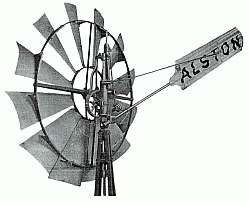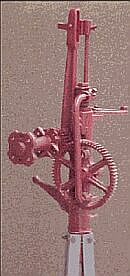


The ALSTON SINGLE CRANK Windmill is a survivor. The design of the engine goes back to the late 1890's, when ALSTON marketed a windmill called the DOT. The parts for the older model are interchangeable with the SINGLE CRANK with the exception of the hub which in the DOT windmill used black iron blades bolted directly onto the hub and had rod stays between the blades to keep the wind wheel tensioned.
The featured windmill was sold from at least 1907, when it was advertised in the 6 & 7 foot formats only. METTERS paid it a great compliment when they produced their 6 foot DORIS Windmill early in the twentieth century with only the vane sheet design changed.

The SINGLE CRANK continued to be sold into the mid 1930's, when it featured in package deals that the company offered. You could have the 6 foot mill with masthead attachment, 6 foot Jarrah tank stand, cut and bored, Jarrah mast, 1000 Gallon tank in sections, brass cylinder pump, foot valve and pipe for $51.50. (The same deal for the ALSTON AQUA windmill cost $46.50).
Various minor changes occurred over the years of manufacture, to the blades, the positioning of the grease cups, three versions of the pitman arm and other minor details. The SINGLE CRANK was actually available at times through its life with 6, 7, 8 and 10 foot wind wheels. At present, to the knowledge of the museum, the 6,7 and 8 foot mills came on the same engine. It would seem a stretch to use the same one for the 10 foot model but that may have been the case.
A very unusual feature of this design is that the main gear shaft and hub shaft are fixed in the main casting. The hub and integral pinion gear, plus the main gear, rotate on the shaft's mild steel to cast with no bearing, just grease cups. What at first appear to be white metal bearings around the shafts, are in fact the method of aligning the shafts to make sure the gear teeth mesh correctly. The gear ratio is 3:1.
This mill seems to have had a good market because they are not all that hard to find in certain areas.